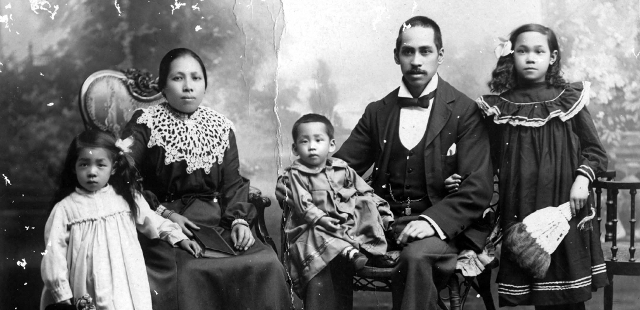Sophie Couchman, Tim Sherratt and I are presenting a session on ‘Representing lives from the archive of White Australia’ at Framing Lives: 8th Biennial Conference of the International Auto/Biography Association on 19 July 2012.
Panel description
This panel offers three approaches to representing the lives of the thousands of men, women and children who were affected by the racially-based immigration policies of late 19th and early 20th-century Australia. To administer the Immigration Restriction Act and its colonial predecessors, government officials implemented an increasingly complex and structured system of tracking and documenting the movements of non-white people as they travelled in and out of the country. This surveillance left an extraordinary body of records containing information about people who, according to the national myth of a ‘White Australia’, were not Australian at all.
The first paper will examine a unique set of almost 300 identification photographs of Chinese Australians taken in Victoria in the late 1890s, considering what these photographs reveal of the lives of their subjects. The second paper will demonstrate how, through a close reading of the records, fragments of biographical information can be built into a portrait of the life of a Chinese woman living in Australia on exemption from 1910 to 1913. The final paper will consider the possibilities of digital history for reconstructing marginalised lives and reflect on the challenges of representing biographical data from the White Australia records in a form that respects its origins and meanings.
Identifying whom?: reading identification photography by Sophie Couchman
In 1900 William Nean posed proudly on his bicycle in full racing attire for the popular photographic company Yeoman & Co. in Bourke Street, Melbourne. He used this photograph as an identification portrait and it is now preserved in the National Archives of Australia amongst 268 other photographic portraits of Chinese resident in Victoria that were created under the administration of the 1890 Chinese Act between 1899 and 1901. The Act aimed to limit and control Chinese immigration in the colony of Victoria and, from the late 1890s, identification portraits of long-term Chinese residents were used as part of documentation to allow them to re-enter Victoria free from the restrictions of the Act.
William Nean’s portrait immediately raises the questions of who he was and why such an unusual photograph was used as an identification portrait. The rest of the paperwork associated with this series of photographs no longer survives—all that remains are annotated identification portraits. This paper will place these photographs in the history of identification photography and, through close readings of them, tease out what can be learnt about the lives of the men, women and children represented in them.
Shifting the lens: uncovering the story of Mrs Poon Gooey by Kate Bagnall
This paper revisits the Poon Gooey deportation case, marking two significant anniversaries. In 1913, it will be a hundred years since Ham Hop, the wife of fruit merchant Poon Gooey, was deported from Australia with their two young daughters. After Ham Hop’s arrival in Australia on a temporary permit in 1910, Poon Gooey—a fluent English-speaker, Christian and member of the Chinese Empire Reform League—mounted a determined campaign to gain permission for her to remain more permanently. The campaign, while ultimately unsuccessful, found widespread support and was an ongoing embarrassment to the federal Labor government.
Fifty years later, historian AT Yarwood wrote on the Poon Gooey case as an example of early problems in the administration of the White Australia Policy. Yarwood based his study on the very substantial Department of External Affairs file, which documents the Poon Gooey story from 1910 to 1913. Greater access to records in the intervening decades, however, means that is now possible to uncover more of the context of Poon Gooey’s actions at this time and, more generally, of the two decades he spent in Australia—evidence that calls into question some of Yarwood’s conclusions about Poon Gooey’s actions and his motivations.
This paper shifts the lens even further, however, to focus on the life of Ham Hop, rather than on that of her husband. Although significant moments in her life—her marriage, periods of physical separation from her husband, travel to Australia, pregnancies, births of her children, medical problems, and finally the deportation of herself and her children—are recorded in the official case files, Ham Hop herself remains silent. Through a close reading of these records and the extensive press coverage of the case, this paper seeks to reveal what can be known of her story and to suggest possibilities for uncovering the lives of women and children who were marginalised and excluded by the White Australia Policy in the early years of the 20th century.
The responsibilities of data: reconstructing lives from the records of the White Australia Policy by Tim Sherratt
The sheer volume of records created by the White Australia Policy is overwhelming. Amidst this vast and disturbing legacy are thousands upon thousands of certificates documenting the movements of non-white residents. These biographical fragments, often including photographs and handprints, are visually and emotionally compelling. We cannot avoid the gaze of those whose lives were monitored, we cannot deny the people behind the policy.
But these records are also a source of data. Increasing numbers of these records have been digitised. As we develop the tools and techniques of digital history, we open up the possibility of extracting this data from the digitised records, of aggregating the biographical fragments, of tracing lives and mapping families. We can tame the overwhelming abundance of records and create a rich, new resource for exploration and analysis.
But how do we avoid imprisoning these newly-liberated lives in yet another system? How do we ensure that the challenging gaze of individuals is not lost in the transformation to data? This paper will look at some of the possibilities for extracting information from these records and reflect on the challenges of representing that data in a form that respects its origins and meanings.




